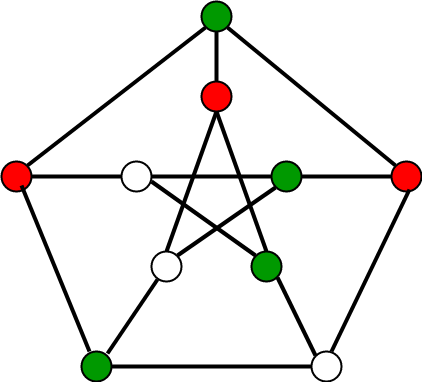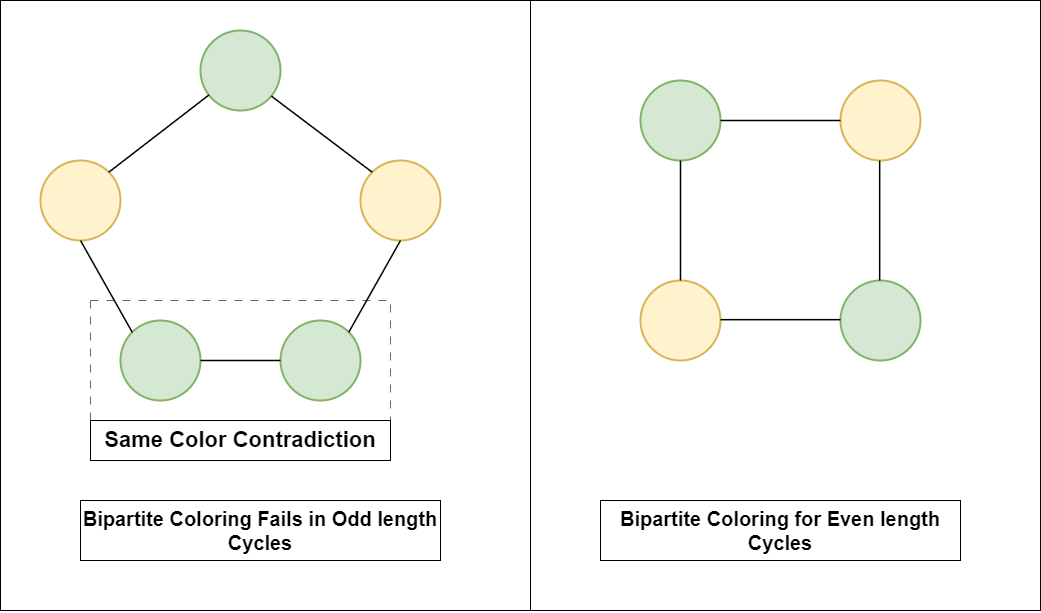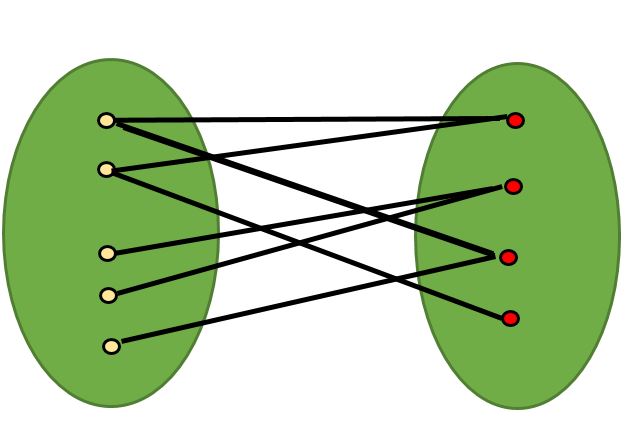Graph Coloring for Competitive Programming
Last Updated :
12 Feb, 2024
Graph coloring in programming refers to the assignment of colors to the vertices of a graph in a way that no two adjacent vertices share the same color. In this article, we will cover the concepts of Graph coloring, why is it important to learn for Competitive Programming and other related concepts like: Bipartite Graph, Chromatic Number, etc.
What is Graph Coloring?
Graph coloring refers to the problem of coloring vertices of a graph in such a way that no two adjacent vertices have the same color. This is also called the vertex coloring problem. If coloring is done using at most m colors, it is called m-coloring.

Importance of Graph Coloring in Competitive Programming(CP):
In CP as the difficulty of problems increases, the problem setter mostly chooses a graph-based problem. The solution of many such problems lies in the concept of graph coloring which mainly revolves around 3 key concepts:
- Bi-partite Coloring
- M-coloring of graph
- Chromatic Numbers
In this article, we will see how these concepts are used in a problem.
Use cases of Bipartite Graph in Competitive Programming:
A bipartite graph is a graph in which the vertices can be divided into two disjoint sets, such that no two vertices within the same set are adjacent. In other words, it is a graph in which every edge connects a vertex of one set to a vertex of the other set.
Identifying Competitive Programming Problems on Bipartite Coloring:
- When The solution Depends upon Parity of the Cycle in the graph
Imagine a problem where the solution exists only when the graph has a cycle of Even length and for Odd length cycles the solution is invalid. In these type of problem Bi-partite coloring is the easiest solution as Bipartite coloring is only possible for Even length cycles as shown in Below image:

- When the solution Depends upon partitioning of graph into two subsets such that vertices in one set only have edges to the vertices of the other set
Using bipartite coloring a graph can be partitioned into two subsets such that all the vertices in the same set, does not contain any edge among them as shown in the image below:

Try to Solve this problem to understand this concept properly.
Template to check if the graph is bipartite or not:
C++
bool ok;
void isBipartite(vector<vector<ll> >& g, vector<ll>& color,
vector<ll>& vis, int node, int paint)
{
if (color[node] != -1 && color[node] != paint) {
ok = false;
return;
}
color[node] = paint;
if (vis[node])
return;
vis[node] = 1;
for (auto child : g[node]) {
isBipartite(g, color, vis, child, paint xor 1);
}
}
|
Java
import java.util.*;
public class GFG {
boolean ok;
void isBipartite(List<List<Long>> g, long[] color, boolean[] vis, int node, int paint) {
if (color[node] != -1 && color[node] != paint) {
ok = false;
return;
}
color[node] = paint;
if (vis[node]) {
return;
}
vis[node] = true;
for (long child : g.get(node)) {
isBipartite(g, color, vis, (int) child, paint ^ 1);
}
}
public static void main(String[] args) {
GFG gfg = new GFG();
}
}
|
Python3
from typing import List
class GFG:
def __init__(self):
self.ok = True
def is_bipartite(self, g: List[List[int]], color: List[int], vis: List[bool], node: int, paint: int):
if color[node] != -1 and color[node] != paint:
self.ok = False
return
color[node] = paint
if vis[node]:
return
vis[node] = True
for child in g[node]:
self.is_bipartite(g, color, vis, child, paint ^ 1)
def main(self):
gfg = GFG()
|
C#
using System;
using System.Collections.Generic;
public class GFG
{
private bool ok;
private void IsBipartite(List<List<long>> g, long[] color, bool[] vis, int node, int paint)
{
if (color[node] != -1 && color[node] != paint)
{
ok = false;
return;
}
color[node] = paint;
if (vis[node])
{
return;
}
vis[node] = true;
foreach (long child in g[node])
{
IsBipartite(g, color, vis, (int)child, paint ^ 1);
}
}
public static void Main(string[] args)
{
GFG gfg = new GFG();
int n = 4;
List<List<long>> graph = new List<List<long>>()
{
new List<long>(){1, 3},
new List<long>(){0, 2},
new List<long>(){1, 3},
new List<long>(){0, 2}
};
long[] color = new long[n];
Array.Fill(color, -1);
bool[] visited = new bool[n];
gfg.ok = true;
for (int i = 0; i < n; i++)
{
if (!visited[i])
{
gfg.IsBipartite(graph, color, visited, i, 0);
}
}
if (gfg.ok)
{
Console.WriteLine("The graph is bi-partite.");
}
else
{
Console.WriteLine("The graph is not bi-partite.");
}
}
}
|
Javascript
class GFG {
constructor() {
this.ok = true;
}
isBipartite(g, color, vis, node, paint) {
if (color[node] !== -1 && color[node] !== paint) {
this.ok = false;
return;
}
color[node] = paint;
if (vis[node]) {
return;
}
vis[node] = true;
for (let child of g[node]) {
this.isBipartite(g, color, vis, child, paint ^ 1);
}
}
static main() {
const gfg = new GFG();
const adjacencyList = [
[1, 2],
[0, 2],
[0, 1]
];
const numNodes = 3;
const color = new Array(numNodes).fill(-1);
const vis = new Array(numNodes).fill(false);
for (let i = 0; i < numNodes; i++) {
if (!vis[i]) {
gfg.isBipartite(adjacencyList, color, vis, i, 0);
}
}
if (gfg.ok) {
console.log("Graph is bipartite.");
} else {
console.log("Graph is not bipartite.");
}
}
}
GFG.main();
|
Time Complexity: O(V+E) where V is the number of edges and E is the number of Edges in the graph.
M-coloring and Chromatic Numbers in Graph Coloring:
The “M-coloring” of a graph refers to the assignment of colors to the vertices of a graph such that no two adjacent vertices share the same color. The chromatic number of a graph is the minimum number of colors needed to color the vertices of the graph in such a way that no two adjacent vertices have the same color.
Use cases in Competitive Programming:
- Map Coloring Problem: In this problem vertices of the graph represents a state/country while the edges represent the border between those countries. The aim of this problem is to provide distinguish attributes to the neighboring states by providing distinguish colors.
- Scheduling Problems: Representing tasks as vertices and dependencies between tasks as edges, the goal is to schedule the tasks in such a way that no two dependent tasks are scheduled at the same time.
- Graph Partitioning: Graph coloring is used in partitioning a graph into different sets or components. This can be applied in problems where we need to calculate the different ways of resource distribution.
- Job Scheduling Problems: Representing jobs as vertices and dependencies as edges, the goal is to maximize the throughput by best resource allocation.
- Four-Color Theorem: Every planar graph can be colored with at most four colors. This concept can be used in advanced problems where the answer depends upon the four coloring of a planar graph.
Practice Problems on Graph Coloring for Competitive Programming:
Share your thoughts in the comments
Please Login to comment...